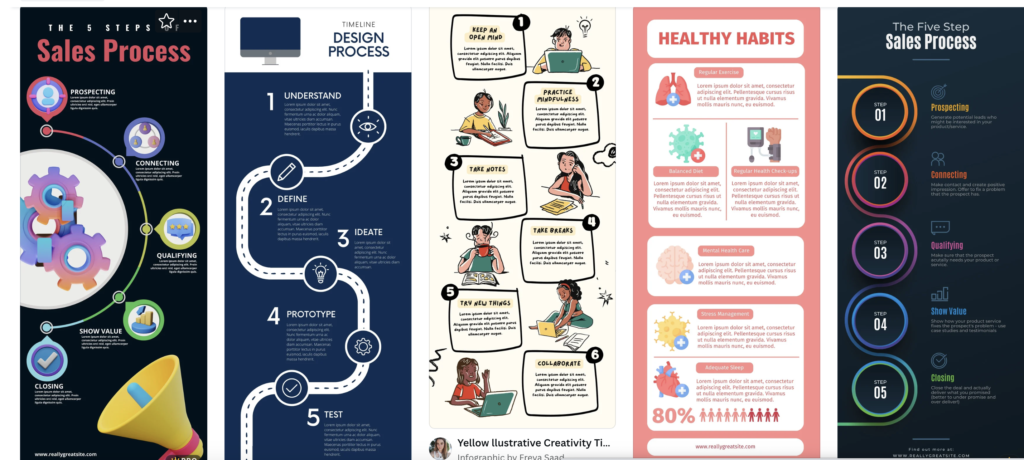In the fast-paced world of social media, a strong content strategy is crucial for financial advisors looking to connect with clients, build their brand, and boost business growth. In this guide, we’ll delve into the various types of content that can boost your social media marketing efforts and help you establish a strong online presence.
1. Educational Content
Educational content should be at the core of your social media strategy as a financial advisor. By sharing valuable information, insights, and knowledge, you can position yourself as an authority in your field. Here are some ways to create educational content:
Infographics: Visual representations of financial concepts or statistics can be highly engaging and easily shareable on platforms like Instagram and LinkedIn. Use user-friendly design tools like Canva to create eye-catching infographics. These graphics should simplify intricate financial ideas, offering your audience digestible insights into topics such as asset allocation or compound interest.

Quick Tips and How-Tos: Share short and actionable financial tips in the form of text or video posts. For example, you can create brief videos explaining the basics of investing, saving for retirement, or managing debt. Be sure to keep these videos concise and to the point, typically under two minutes, as attention spans on social media are notoriously short.
Thought Leadership Articles: Share informative articles and blog posts on topics like investment strategies, retirement planning, education funding, and financial markets. These posts should be well-researched and offer actionable advice. It’s essential to maintain a blog on your website and share the articles on social media to drive traffic and showcase your expertise.
Educational content helps you attract and retain a dedicated following of individuals seeking your expertise. Providing valuable insights and information will establish you as a reliable source of financial knowledge.
2. Testimonials and Client Success Stories
Building trust is essential for financial advisors, and sharing client testimonials and success stories can be a powerful way to achieve this. These posts can include:
Client Testimonials: Share short quotes or videos where satisfied clients discuss how your services have benefited them. Ensure you have their consent to use their images and testimonials. Check with your compliance department to make sure you adhere to FINRA rules.
Before-and-After Stories: Show real-life examples of clients who achieved financial success with your guidance. You can create longer more in-depth posts or stories about these clients, highlighting their financial goals, challenges, and the solutions you provided. Again, only do this with the client’s full permission and make sure it is compliant with industry standards.
Case Studies: Share detailed case studies that highlight your expertise in helping clients reach their financial goals. These studies should outline the specific challenges clients faced, the strategies you implemented, and the successful outcomes achieved.
By showcasing the real impact of your services, you can build a strong connection with your audience and make your brand more relatable. Highlighting these stories shows prospective clients that you have a track record of helping people achieve their financial goals.
3. Industry Insights and News
Staying up to date with industry news and trends is crucial. Sharing your insights on current events and their potential impact on clients can position you as a knowledgeable resource. Here’s how to incorporate industry news into your social media strategy:
Market Updates: Regularly provide brief updates on market trends and economic news. These posts should be timely and relevant, giving your audience the information they need to stay informed about their investments.
Analysis and Commentary: Offer your expert analysis on how recent events may affect your clients’ financial situations.
Sharing industry insights keeps your content relevant and demonstrates your commitment to staying informed, which can help you gain the trust of your audience.
4. Interactive Content
Interactive content can boost engagement and encourage participation on your social media platforms. Consider these types of interactive content:
Polls and Surveys: Use polls and surveys to gather insights from your audience on relevant financial topics. Create polls on platforms like Instagram or LinkedIn, asking questions like “What is your preferred investment horizon: short-term, medium-term, or long-term?” or “Which investment vehicle do you find most appealing: stocks, bonds, or real estate?”
Quizzes: Create quizzes that allow your audience to test their financial knowledge. Use platforms like Quizlet or QuizMaker to develop fun and informative quizzes. Topics can range from personal finance basics to more advanced investment concepts.

Interactive content not only keeps your audience engaged but can also provide valuable data and insights to tailor your services to your clients’ needs better. Use the feedback and data from polls, surveys, and quizzes to refine your content and adapt your services.
5. Optimizing Your Social Media Posts
Your social media platforms should be a primary avenue for connecting with your audience. Optimize your social media content by creating:
Regular Updates: Share timely updates on financial news and trends to demonstrate your expertise. For example, you can post daily or weekly updates on stock market performance, economic indicators, or recent financial news.
Visual Content: Share engaging images and videos that accompany your posts. Visual content tends to perform well on social media platforms, increasing your content’s reach and engagement. You can use tools like Canva to create visually appealing images and videos.
Engagement Posts: Create posts that encourage interaction, such as asking questions or conducting polls. Ask questions like, “What are your top financial goals for the next five years?” or “What financial topics would you like us to cover in our next educational video?”
Personal Posts: Share occasional personal updates to give your audience a glimpse of your life outside of work. These posts should be in line with your professional image and may include personal milestones, hobbies, or community involvement. Personal posts help humanize your brand and make you more relatable.
Each platform has its unique characteristics, so tailor your content to your target audience and the platform you are using. Consistency is key to maintaining a strong social media presence. Create a content calendar to plan your posts, ensuring you maintain a steady stream of content.
The Bottom Line
To wrap it up, a successful social media content strategy for financial advisors focuses on educational content, testimonials, industry insights, interactive content, and regular social media posts. By leveraging these content types, you can effectively connect with your audience, build trust, and demonstrate your expertise.
Mastering these content types will not only boost your social media marketing efforts but also help you establish a strong online presence in a competitive industry.




